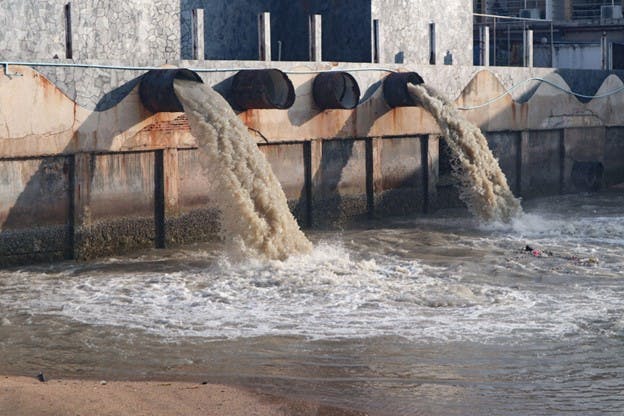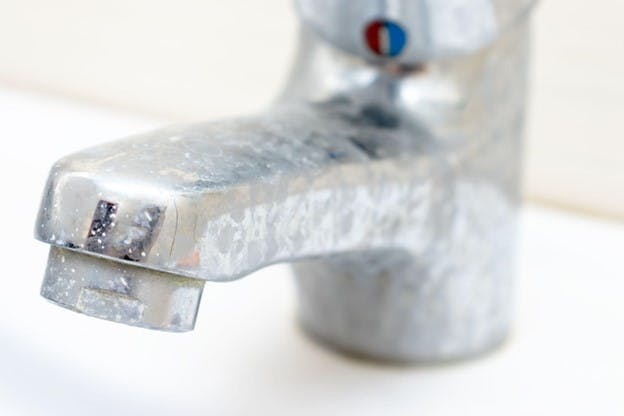February 2024
Clearing the Smoke on Cleveland Water Quality
Cleveland, Ohio is a city of important firsts. The first rock concert, the first Black mayor of a large city, the first indoor shopping mall, and even the first car was sold in Cleveland. And while it wasn’t the first to have a river catch on fire, it was the first one to capture the country’s attention enough that we decided to do something about it.
Water pollution in Cleveland is the reason we have the U.S. Environmental Protection Agency (EPA) and federal laws protecting lakes, rivers, and even drinking water. With this in mind, we wanted to take a closer look at just how Cleveland water quality has changed over the years and get a better understanding of what’s flowing from your faucet.
In this article we’re going to take a deep dive into the Cleveland water quality report. We’ll tell you where your water comes from, what’s in it, and what, if anything, you need to do to protect your tap.
Where Does Cleveland Water Come From?
Cleveland tap water comes from Lake Erie, which is a surface water system and the most biologically productive of the Great Lakes. With Cleveland Water providing 80 different communities over 200 million gallons of water daily, it is the 10th largest water utility in the country.
Water is pulled from the Central Basin of Lake Erie through four different intakes which span a 15-mile stretch. Each intake is 3-5 miles from the shore, where water is cleaner and less likely to be contaminated by coastal activity and pollution from the Cuyahoga River.
Once the source water is pulled from the lake, it is sent to one of four water treatment plants in order to prepare it for safe use.

How Is Cleveland Water Treated?
Cleveland’s public water systems rely on a conventional treatment process to provide clean water to Clevelanders. The process consists of several steps and a variety of chemicals all used to meet drinking water standards created by the U.S. EPA and the Ohio EPA.
Screens
First water is run through screens as it enters the intakes which are located 50 feet below the surface of Lake Erie. This keeps fish and large debris from getting pulled into the intakes.
Coagulation and Flocculation
A coagulant called aluminum sulfate is mixed rapidly into the water. The water mixture then goes through three stages of chambers that progressively calm the water so the small particles clump together into floc.
Sedimentation
Once the particles of organic and inorganic material clump together, the heavy floc clumps are given time to sink to the bottom of sediment tanks, leaving clear water at the top to go through the next stages.
Filtration
With the larger particles removed from the water, it is run through a gravity filter made of anthracite and sand to remove smaller impurities.
Disinfecting and Finishing
This is where the now filtered water is treated with chemicals like chlorine to kill pathogens, fluoride for dental health, and sodium hydroxide and phosphoric acid to protect water mains and plumbing fixtures from leaching dangerous metals into the water.
Testing and Pumping
Water samples are then taken and tested before the treated water is sent to customers. The distribution system consists of over 5,300 miles of water mains, 21 water towers, and 17 pumping stations across the city of Cleveland.
Is Cleveland Water Clean?
It’s no secret that Cleveland has had problems with water pollution in its past. It was just over 50 years ago when Time Magazine described the Cuyahoga River as oozing rather than flowing. When the surface of the river burst into flames, it spurred the creation of the Clean Water Act and U.S. EPA. If one thing is certain, it's that Cleveland water quality has improved dramatically since 1969. But is it enough?
In 2009, the fish in the Cuyahoga River was able to be eaten and the river can even now be used for recreation. However, despite these significant improvements, Cleveland's water quality still faces a lot of challenges. The Northeast Ohio Regional Sewer District has had to issue several health advisories at Edgewater Park due to sewage and stormwater overflows into Lake Erie following heavy rainfall. The city still has outdated “combined” sewer systems where stormwater and sewage share the same pipes, spill untreated sewage, and cause e.coli outbreaks in Lake Eerie every time it rains heavily.
And the river that started the country down the path of cleanup is still officially an Area of Concern in the eyes of the EPA. Still, it’s come a long way.
Is It Safe to Drink the Tap Water in Cleveland?
According to the Cleveland Water Quality Report and the U.S. Environmental Protection Agency, Cleveland tap water is safe to drink. It’s important to note, though, that meeting regulatory standards doesn’t always mean water is free of harmful contaminants.
Currently, the U.S. EPA regulates 92 water contaminants but there are thousands of potential contaminants that we don’t know much about. Some, like microplastics, are found in water supplies all over the world, but they remain unregulated contaminants in drinking water since accurately testing for them remains a challenge.
Drinking water regulations work to strike a balance between safeguarding public health and keeping water treatment cost effective. When the expense of removing a specific contaminant is prohibitively high, regulatory agencies have little choice but to allow higher threshold levels in the water supply until better testing and removal tech comes around.
This is partly why the Environmental Working Group (EWG) says EPA regulation doesn’t keep up with modern health science. In fact, the last update to water regulations was almost 20 years ago, even though our understanding of many threats in our water has changed since then.

Which Chemicals Are Hurting Cleveland Water Quality?
Cleveland water quality has several issues with chemical contaminants. While they all fall within legal limits, many experts believe these levels are still well above where they should be to protect public health. Here’s a few of the chemicals found in Cleveland drinking water that are considered to be too high by the Environmental Working Group.
Haloacetic Acids (HAA5)
HAA5 is made up of five haloacetic acids: monochloroacetic acid, dichloroacetic acid, trichloroacetic acid, monobromoacetic acid, and dibromoacetic acid. These chemicals are known as disinfection byproducts, as they result from disinfectants like chlorine interacting with organic matter in water. Long-term exposure to HAA5 can lead to cancer.
Levels of HAA5 in Cleveland water have exceeded what the EWG recommends for safety by 181 times:
- EPA maximum allowance: 60 parts per billion (ppb)
- EWG recommended maximum: 0.1 ppb
- Cleveland maximum contaminant level: 18.1 ppb
Haloacetic Acids (HAA9)
HAA9 includes all of the contaminants from HAA5 but adds bromochloroacetic acid, bromodichloroacetic acid, chlorodibromoacetic acid, and tribromoacetic acid. These are also disinfection byproducts and are also cancer-causing.
Levels of HAA9 in Cleveland water have exceeded what the EWG recommends for safety by 342 times:
- EPA maximum allowance: No legal limit
- EWG recommended maximum: 0.06 ppb
- Cleveland maximum contaminant level: 20.5 ppb
Total Trihalomethanes (TTHMs)
TTHMs — like the haloacetic acids above — are formed when chlorine interacts with organic compounds in drinking water. They’re also known to be carcinogenic. This category is made up of four chemicals: chloroform, bromodichloromethane, dibromochloromethane, and bromoform.
Levels of TTHMs in Cleveland water have exceeded what the EWG recommends for safety by 169 times:
- EPA maximum allowance: 80 ppb
- EWG recommended maximum: 0.15 ppb
- Cleveland maximum contaminant level: 25.4 ppb
Chromium (Hexavalent)
Chromium is another common contaminant found in U.S. water supplies. It can occur naturally but is also an industrial pollutant. Although it’s known to be a carcinogen, this contaminant is still unregulated by the EPA.
Chromium levels in Cleveland water have exceeded what the EWG recommends for safety by 5.1 times:
- EPA maximum allowance: No legal limit
- EWG recommended maximum: 0.02 ppb
- Cleveland maximum detected level: 0.103 ppb
Nitrates
Nitrates usually end up in water supplies through stormwater runoff from fertilizers, but they can also come from septic tanks. They can cause oxygen deprivation in infants and increase the risk of certain cancers.
Nitrate levels in Cleveland water have exceeded what the EWG recommends for safety by 2.4 times:
- EPA maximum allowance: 10 parts per million (ppm)
- EWG recommended maximum: 0.14 ppm
- Cleveland maximum detected level: 0.333 ppm

Does Cleveland Have Hard Water?
Cleveland has moderately hard water. Water hardness measures the concentrations of dissolved minerals like calcium and magnesium in the water. The more minerals deposited in the water, the harder it is considered.
Hard water is not a health concern in drinking water but it can damage your skin and it can be a nightmare for your home. Because water is a powerful solvent, it tends to dissolve and pick up minerals and other contaminants as it passes over dirt and rocks as ground water. These minerals are carried along until they get redeposited elsewhere. That often means your pipes, tiles, or your skin.
They also mix with soap to create soap scum. This makes your soap less effective and it sticks to your surfaces, creating a nasty grime bacteria can grow on. If you are dealing with Cleveland’s hard water, a water softener or salt-free water conditioner will upgrade your life.
Does Cleveland Add Fluoride to Drinking Water?
Yes, Cleveland does add fluoride to drinking water during the water treatment process. Drinking water with fluoride is known to fight cavities and strengthen tooth enamel in children and adults.
While many people welcome the benefits of fluoride, others would rather control their own fluoride intake through fluoridated products like toothpaste and mouthwash. If you’d rather get rid of the fluoride in your tap water, it's important to understand that traditional water treatment methods like boiling or using activated charcoal filters won’t remove it. To remove fluoride from water, you’ll need a high-quality reverse osmosis filter.

Get the Best Quality Water in Your Cleveland Home
Since 1969 when a fire in the Cuyahoga River launched the creation of the U.S. EPA, the city of Cleveland has worked hard to turn everything around. While the city has come a long way, Cleveland water quality still has a long way to go until the local watersheds and its drinking water quality are the best they can be.
If you want the best possible water quality from your faucet, HomeWater can help. HomeWater's American-made UPSTREAM 4-Stage Whole Home Water Filters can improve your water quality by removing impurities like sediment, pesticides, chlorine, DPBs, nitrates, microplastics, chromium, and more.
Make your Cleveland water quality better with HomeWater.